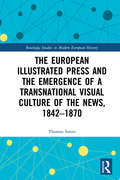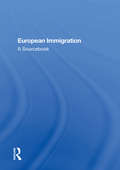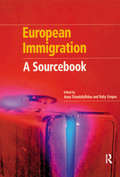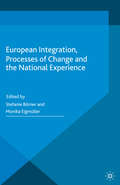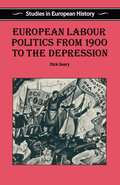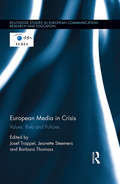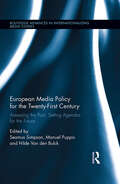- Table View
- List View
The European Illustrated Press and the Emergence of a Transnational Visual Culture of the News, 1842-1870 (Routledge Studies in Modern European History)
by Thomas SmitsThis book looks at the roots of a global visual news culture: the trade in illustrations of the news between European illustrated newspapers in the mid-nineteenth century. In the age of nationalism, we might suspect these publications to be filled with nationally produced content, supporting a national imagined community. However, the large-scale transnational trade in illustrations, which this book uncovers, points out that nineteenth-century news consumers already looked at the same world. By exchanging images, European illustrated newspapers provided them with a shared, transnational, experience.
European Immigration: A Sourcebook
by Anna TriandafyllidouWho are Europe's immigrants? This innovative volume provides a comprehensive overview of the immigration situation in all 25 EU countries. Each chapter is written by an expert and follows a common structure, allowing direct comparisons to be made between countries. Chapters provide a clear focus in terms of the methods used, data collected, literature reviewed and research questions addressed, and draw on hard-to-obtain material, including sources not previously published in English. Each chapter concludes with a critical assessment of the present migration situation of the country in question and its future prospects. Substantive introductory and concluding chapters offer a general overview of immigration in Europe, which complements and contextualizes the analytical and comparative insights of the individual countries. The first reference volume to provide comprehensive coverage of the EU, European Immigration will be essential for library collections and for scholars and policy-makers in the field.
European Immigration: A Sourcebook
by Anna TriandafyllidouWho are Europe's immigrants? This innovative volume provides a comprehensive overview of the immigration situation in all 25 EU countries. Each chapter is written by an expert and follows a common structure, allowing direct comparisons to be made between countries. Chapters provide a clear focus in terms of the methods used, data collected, literature reviewed and research questions addressed, and draw on hard-to-obtain material, including sources not previously published in English. Each chapter concludes with a critical assessment of the present migration situation of the country in question and its future prospects. Substantive introductory and concluding chapters offer a general overview of immigration in Europe, which complements and contextualizes the analytical and comparative insights of the individual countries. The first reference volume to provide comprehensive coverage of the EU, European Immigration will be essential for library collections and for scholars and policy-makers in the field.
European Immigration: A Sourcebook
by Anna Triandafyllidou Ruby GropasFully updated and containing chapters on the new EU member states and the attempt to form a common EU migration policy, this new edition of European Immigration: A Sourcebook provides a comprehensive overview of the trends and developments in migration in all EU countries. With chapters following a common structure to facilitate direct international comparisons, it not only examines the internal affairs of each member state, but also explores both migratory trends within the EU itself and the implications for European immigration of wider global events, including the Arab Spring and the world financial crisis.
European Immigration: A Sourcebook
by Anna Triandafyllidou Ruby GropasFully updated and containing chapters on the new EU member states and the attempt to form a common EU migration policy, this new edition of European Immigration: A Sourcebook provides a comprehensive overview of the trends and developments in migration in all EU countries. With chapters following a common structure to facilitate direct international comparisons, it not only examines the internal affairs of each member state, but also explores both migratory trends within the EU itself and the implications for European immigration of wider global events, including the Arab Spring and the world financial crisis.
European Imperialism and the Third World
by Abdul Qayyum KhanThis book presents a comprehensive overview of the evolution of imperialism in Portugal, Spain, the Netherlands, France, and Great Britain. It delves into the background of colonialization and focuses on the nature of the motives of necessity, utility, religion, and exploration and the modus operandi of the establishment of the colonies which required a substantial amount of capital. The volume discusses a wide range of themes, including the role of Spain as a Muslim colony; rise and fall of Spain as an imperial power; Portuguese discoveries and colonialization; conquests of Dutch companies of East India and West Indies; the French company of the Indies; British colonies in Americas, Africa, and Australasia; and English East India Company to showcase a holistic history of European competition for trade through wars in North America, South America, Africa, Australia, New Zealand, and Asia. This book will be of interest to general readers interested in the history of colonization, imperialism, Third World studies, post-colonial studies, international relations, defense and strategic studies, South Asian history, and European history.
European Imperialism and the Third World
by Abdul Qayyum KhanThis book presents a comprehensive overview of the evolution of imperialism in Portugal, Spain, the Netherlands, France, and Great Britain. It delves into the background of colonialization and focuses on the nature of the motives of necessity, utility, religion, and exploration and the modus operandi of the establishment of the colonies which required a substantial amount of capital. The volume discusses a wide range of themes, including the role of Spain as a Muslim colony; rise and fall of Spain as an imperial power; Portuguese discoveries and colonialization; conquests of Dutch companies of East India and West Indies; the French company of the Indies; British colonies in Americas, Africa, and Australasia; and English East India Company to showcase a holistic history of European competition for trade through wars in North America, South America, Africa, Australia, New Zealand, and Asia. This book will be of interest to general readers interested in the history of colonization, imperialism, Third World studies, post-colonial studies, international relations, defense and strategic studies, South Asian history, and European history.
European Integration and Housing Policy (Routledge/rics Issues In Real Estate And Housing Ser.)
by Mark Kleinman Walter Matznetter Mark StephensThis book presents a series of debates arising from the housing needs of different EU countries. The authors address key issues by examining in turn: * the consequences of European integration for different housing markets * the impact of the Maastricht Treaty and other policy documents * the social consequences of integration including income distribution, homelessness and marginal housing estates * current housing policy in the Nordic countries and in Eastern Europe.
European Integration and Housing Policy
by Mark Kleinman Walter Matznetter Mark StephensThis book presents a series of debates arising from the housing needs of different EU countries. The authors address key issues by examining in turn: * the consequences of European integration for different housing markets * the impact of the Maastricht Treaty and other policy documents * the social consequences of integration including income distribution, homelessness and marginal housing estates * current housing policy in the Nordic countries and in Eastern Europe.
European Integration and Rural Development: Actors, Institutions and Power
by Michael KullTo understand fully the process of European integration, it is necessary to consider developments at the sub-national and local level. EU integration scholars have been examining the local level using the concept of multi-level governance (MLG) since the 1990s. While MLG was the first concept to scrutinize the position of local levels of public administration and other actors within the EU polity, it overestimates the degree of influence it ascribes to local levels, particularly as far as the rural is concerned. Focusing on Germany and Finland, with country specific information from all EU member states, this book combines MLG with the concept of structural constructivism, in order to reveal some of the hidden aspects of EU integration. Bringing together these concepts and methodologies and replacing mainstream theories of integration with this new approach, offers a more accurate picture of multi-level interaction in rural policy and of the impacts of European integration at the local level. By examining the Community Initiative LEADER+ and setting this within a discussion of the state and structure of rural development policy, this book looks at the challenges, opportunities and policy options which are available and have been implemented in rural development. It shows that these are often context dependent and that the future of rural development policies, their shape and institutional configuration depend on reforms put in place at all levels of governance. Finally, it argues that the MLG of rural development policy must be built with people who have the know-how and the (local) knowledge to implement development projects and who have made LEADER a success in the past.
European Integration and Rural Development: Actors, Institutions and Power (Perspectives On Rural Policy And Planning Ser.)
by Michael KullTo understand fully the process of European integration, it is necessary to consider developments at the sub-national and local level. EU integration scholars have been examining the local level using the concept of multi-level governance (MLG) since the 1990s. While MLG was the first concept to scrutinize the position of local levels of public administration and other actors within the EU polity, it overestimates the degree of influence it ascribes to local levels, particularly as far as the rural is concerned. Focusing on Germany and Finland, with country specific information from all EU member states, this book combines MLG with the concept of structural constructivism, in order to reveal some of the hidden aspects of EU integration. Bringing together these concepts and methodologies and replacing mainstream theories of integration with this new approach, offers a more accurate picture of multi-level interaction in rural policy and of the impacts of European integration at the local level. By examining the Community Initiative LEADER+ and setting this within a discussion of the state and structure of rural development policy, this book looks at the challenges, opportunities and policy options which are available and have been implemented in rural development. It shows that these are often context dependent and that the future of rural development policies, their shape and institutional configuration depend on reforms put in place at all levels of governance. Finally, it argues that the MLG of rural development policy must be built with people who have the know-how and the (local) knowledge to implement development projects and who have made LEADER a success in the past.
European Integration, Processes of Change and the National Experience (Palgrave Studies in European Political Sociology)
by Stefanie Börner Monika EigmüllerIn order to better understand processes of European integration, this book offers a new perspective that compares past experiences of change to current transitional moments at the European level. It addresses key questions about European society, EU integration and social change to reveal the social construction of emergent polities and societies.
The European Iron Age
by John CollisThis ambitious study documents the underlying features which link the civilizations of the Mediterranean - Phoenician, Greek, Etruscan and Roman - and the Iron Age cultures of central Europe, traditionally associated with the Celts. It deals with the social, economic and cultural interaction in the first millennium BC which culminated in the Roman Empire.The book has three principle themes: the spread of iron-working from its origins in Anatolia to its adoption over most of Europe; the development of a trading system throughout the Mediterrean world after the collapse of Mycenaean Greece and its spread into temperate Europe; and the rise of ever more complex societies, including states and cities, and eventually empires.Dr Collis takes a new look at such key concepts as population movement, diffusion, trade, social structure and spatial organization, with some challenging new views on the Celts in particular.
The European Iron Age
by John CollisThis ambitious study documents the underlying features which link the civilizations of the Mediterranean - Phoenician, Greek, Etruscan and Roman - and the Iron Age cultures of central Europe, traditionally associated with the Celts. It deals with the social, economic and cultural interaction in the first millennium BC which culminated in the Roman Empire.The book has three principle themes: the spread of iron-working from its origins in Anatolia to its adoption over most of Europe; the development of a trading system throughout the Mediterrean world after the collapse of Mycenaean Greece and its spread into temperate Europe; and the rise of ever more complex societies, including states and cities, and eventually empires.Dr Collis takes a new look at such key concepts as population movement, diffusion, trade, social structure and spatial organization, with some challenging new views on the Celts in particular.
European Labour Politics from 1900 to the Depression (Studies in European History)
by Dick GearyMost European states saw the rise of independent working-class politics before 1918 and labour movements were already prominent on the political landscape by the outbreak of war. This book attempts to explain the emergence of labour politics, which workers organised and why the views they held about politics varied from one country to another. It then explores the impact of war and revolution on European labour, asking why workers enjoyed political success in some places and not in others. A crucial factor was the division of labour politics into two hostile camps, a division which proved fatal in some places in the face of fascism.
European Landscapes of Rock-Art
by Christopher Chippindale George NashRock-art - the ancient images which still scatter the rocky landscapes of Europe - is a singular kind of archaeological evidence. Fixed in place, it does not move about as artefacts as trade objects do. Enigmatic in its meaning, it uniquely offers a direct record of how prehistoric Europeans saw and envisioned their own worlds. European Landscapes of Rock-Art provides a number of case studies, covering arange of European locations including Ireland, Italy, Scandinavia, Scotland and Spain, which collectively address the chronology and geography of rock-art as well as providing an essential series of methodologies for future debate. Each author provides a synthesis that focuses on landscape as an essential part of rock-art construction. From the paintings and carved images of prehistoric Scandinavia to Second World War grafitti on the German Reichstag, this volume looks beyond the art to the society that made it. The papers in this volume also challenge the traditional views of how rock-art is recorded. Throughout, there is an emphasis on informal and informed methodologies. The authors skilfully discuss subjectivity and its relationship with landscape since personal experience, from prehistoric times to the present day, plays an essential role in the interpretation of art itself. The emphasis is on location, on the intentionality of the artist, and on the needs of the audience. This exciting volume is a crucial addition to rock-art literature and landscape archaeology. It will provide new material for a lively and greatly debated subject and as such will be essential for academics, non-academics and commentators of rock art in general.
European Landscapes of Rock-Art
by George Nash Christopher ChippindaleRock-art - the ancient images which still scatter the rocky landscapes of Europe - is a singular kind of archaeological evidence. Fixed in place, it does not move about as artefacts as trade objects do. Enigmatic in its meaning, it uniquely offers a direct record of how prehistoric Europeans saw and envisioned their own worlds. European Landscapes of Rock-Art provides a number of case studies, covering arange of European locations including Ireland, Italy, Scandinavia, Scotland and Spain, which collectively address the chronology and geography of rock-art as well as providing an essential series of methodologies for future debate. Each author provides a synthesis that focuses on landscape as an essential part of rock-art construction. From the paintings and carved images of prehistoric Scandinavia to Second World War grafitti on the German Reichstag, this volume looks beyond the art to the society that made it. The papers in this volume also challenge the traditional views of how rock-art is recorded. Throughout, there is an emphasis on informal and informed methodologies. The authors skilfully discuss subjectivity and its relationship with landscape since personal experience, from prehistoric times to the present day, plays an essential role in the interpretation of art itself. The emphasis is on location, on the intentionality of the artist, and on the needs of the audience. This exciting volume is a crucial addition to rock-art literature and landscape archaeology. It will provide new material for a lively and greatly debated subject and as such will be essential for academics, non-academics and commentators of rock art in general.
The European Left and the Jewish Question, 1848-1992: Between Zionism and Antisemitism
by Alessandra TarquiniThis book examines how left-wing political and cultural movements in Western Europe have considered Jews in the last two hundred years. The chapters seek to answer the following question: has there been a specific way in which the Left has considered Jewish minorities? The subject has taken various shapes in the different geographical contexts, influenced by national specificities. In tandem, this volume demonstrates the extent to which left-wing movements share common trends drawn from a collective repertoire of representations and meanings. Highlighting the different aspects of the subject matter, the chapters in this book are divided in three parts, each dedicated to a major theme: the contribution of the theorists of Socialism to the Jewish Question; Antisemitism and its representations in left-wing culture; and the perception of the Arab-Israeli conflict. Taken together, these three themes allow for a multidisciplinary analysis of the relationship between the Left and Jews from the second half of the nineteenth century to recent times.
European Media (Global Media and Communication)
by Stylianos Papathanassopoulos Ralph M. NegrineEuropean Media provides a clear, concise account of the structures, dynamics and realities of the changing face of media in Europe. It offers a timely and illuminating appraisal of the issues surrounding the development of new media in Europe and explores debates about the role of the media in the formation of a European public sphere and a European identity. The book argues that Europe offers an ideal context for examining interactions between global, regional and national media processes and its individual chapters consider: the changing structure of the European media; the development of new media; the Europeanization of the media in the region; the challenges for the content; and audiences. Special emphasis is given to the transformation of political communication in Europe and the alleged emergence of a European public sphere and identity. European Media: Structures, Politics and Identity is an invaluable text for courses on media and international studies as well as courses dealing with European and national policy studies. It is also helpful to students, researchers and professionals in the media sector since it combines hard facts with theoretical insight.
European Media (Global Media and Communication)
by Stylianos Papathanassopoulos Ralph M. NegrineEuropean Media provides a clear, concise account of the structures, dynamics and realities of the changing face of media in Europe. It offers a timely and illuminating appraisal of the issues surrounding the development of new media in Europe and explores debates about the role of the media in the formation of a European public sphere and a European identity. The book argues that Europe offers an ideal context for examining interactions between global, regional and national media processes and its individual chapters consider: the changing structure of the European media; the development of new media; the Europeanization of the media in the region; the challenges for the content; and audiences. Special emphasis is given to the transformation of political communication in Europe and the alleged emergence of a European public sphere and identity. European Media: Structures, Politics and Identity is an invaluable text for courses on media and international studies as well as courses dealing with European and national policy studies. It is also helpful to students, researchers and professionals in the media sector since it combines hard facts with theoretical insight.
European Media in Crisis: Values, Risks and Policies (Routledge Studies in European Communication Research and Education)
by Josef Trappel Jeanette Steemers Barbara ThomassWhen the financial markets collapsed in 2008, the media industry was affected by a major slump in advertising revenues, and a formerly highly successful business model fell into a state of decay. This economic crisis has threatened core social values of contemporary democracies, such as freedom, diversity and equality. Taking a normative and policy perspective, this book discusses threats and opportunities for the media industry in Europe: What are the implications of the crisis for professional journalism, the media industry, and the process of political communication? Can non- state and non-market actors profit from the crisis? And what are media policy answers at the national and European level?
European Media in Crisis: Values, Risks and Policies (Routledge Studies in European Communication Research and Education)
by Josef Trappel Jeanette Steemers Barbara ThomassWhen the financial markets collapsed in 2008, the media industry was affected by a major slump in advertising revenues, and a formerly highly successful business model fell into a state of decay. This economic crisis has threatened core social values of contemporary democracies, such as freedom, diversity and equality. Taking a normative and policy perspective, this book discusses threats and opportunities for the media industry in Europe: What are the implications of the crisis for professional journalism, the media industry, and the process of political communication? Can non- state and non-market actors profit from the crisis? And what are media policy answers at the national and European level?
European Media in the Digital Age: Analysis and Approaches
by Richard RookeThis introductory textbook for Media and Communication Studies students is designed to encourage observation and evaluation of the European media in the digital age, enabling students to grasp key concepts and gain a broad and clear overview of the area. It also introduces the principal debates, developments (legislative, commercial, political and technological) and issues shaping the European media today, and examines in depth the mass media, digital media, the internet and new media policy. Understanding today's media scene from print to audiovisual needs a wider view and this book helps make comprehensible the European media within a broader global media landscape. The text is pedagogically rich and explores a variety of approaches to help the reader gain a better understanding of the European media world. Students are encouraged to start thinking about statistics, relating this to economics, analysing regulations, and combining media theories with theories of European Union integration. The book also includes the use of case studies, illustrations, summaries, critical reflections and directions to wider reading. The European Media in the Digital Age is recommended for all Media Studies students and is also of key interest to students of Politics and Policy, Business Studies, International Studies and European Studies
European Media in the Digital Age: Analysis and Approaches
by Richard RookeThis introductory textbook for Media and Communication Studies students is designed to encourage observation and evaluation of the European media in the digital age, enabling students to grasp key concepts and gain a broad and clear overview of the area. It also introduces the principal debates, developments (legislative, commercial, political and technological) and issues shaping the European media today, and examines in depth the mass media, digital media, the internet and new media policy. Understanding today's media scene from print to audiovisual needs a wider view and this book helps make comprehensible the European media within a broader global media landscape. The text is pedagogically rich and explores a variety of approaches to help the reader gain a better understanding of the European media world. Students are encouraged to start thinking about statistics, relating this to economics, analysing regulations, and combining media theories with theories of European Union integration. The book also includes the use of case studies, illustrations, summaries, critical reflections and directions to wider reading. The European Media in the Digital Age is recommended for all Media Studies students and is also of key interest to students of Politics and Policy, Business Studies, International Studies and European Studies
European Media Policy for the Twenty-First Century: Assessing the Past, Setting Agendas for the Future (Routledge Advances in Internationalizing Media Studies)
by Seamus Simpson Manuel Puppis Hilde Van Den BulckMedia policy issues sit at the heart of the structure and functioning of media systems in Europe and beyond. This book brings together the work of a range of leading media policy scholars to provide inroads to a better understanding of how effective media policies can be developed to ensure a healthy communication sector that contributes to the wellbeing of individual citizens, as well as a more democratic society. Faced with a general atmosphere of disillusionment in the European project, one of the core questions tackled by the volume’s contributors is: what scope is there for European media policy that can exist beyond the national level? Uniquely, the volume’s chapters are structured around four key policy themes: media convergence; the continued role and position of public regulatory intervention in media policy; policy issues arising from the development of new electronic communication network environments; and lessons for European media policy from cases beyond the EU. In its chapters, the volume provides enriched understandings of the role and significance of policy actors, institutions, structures, instruments and processes in communication and media policy.
